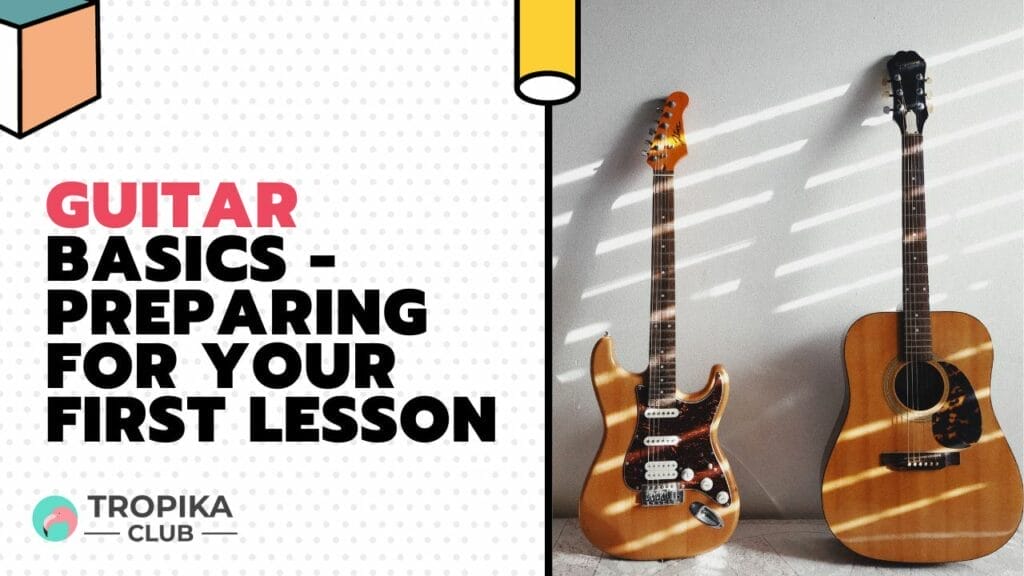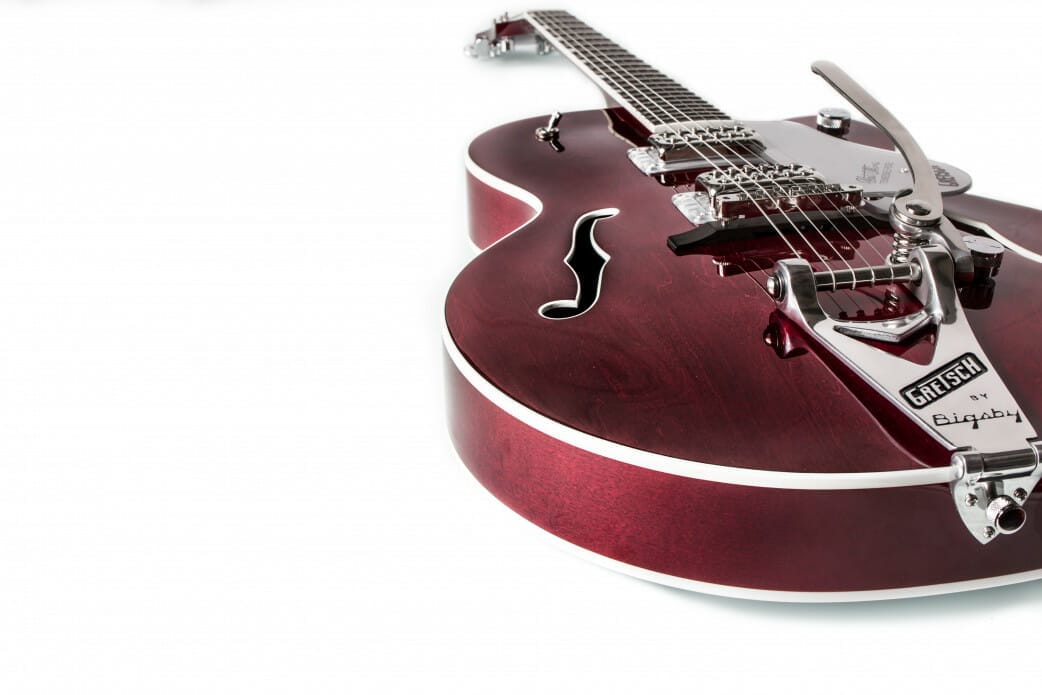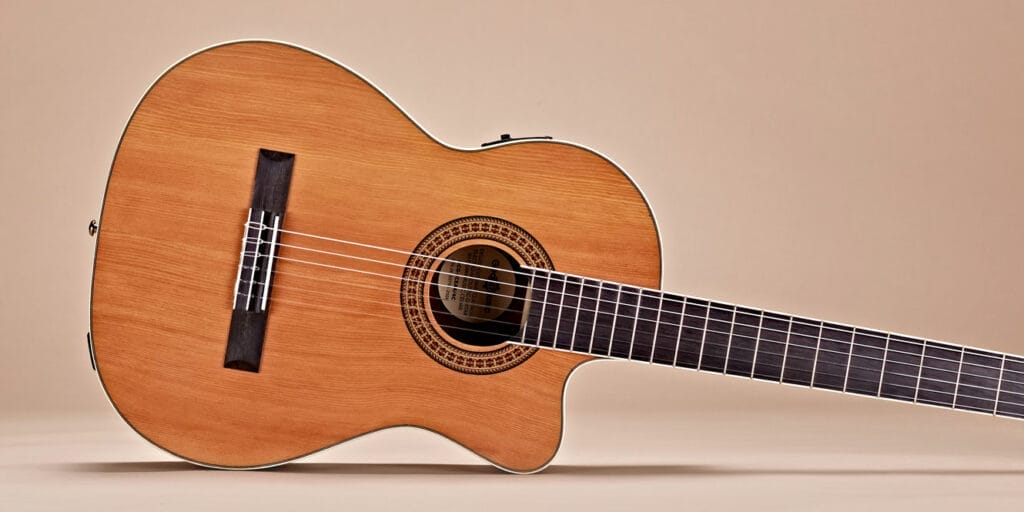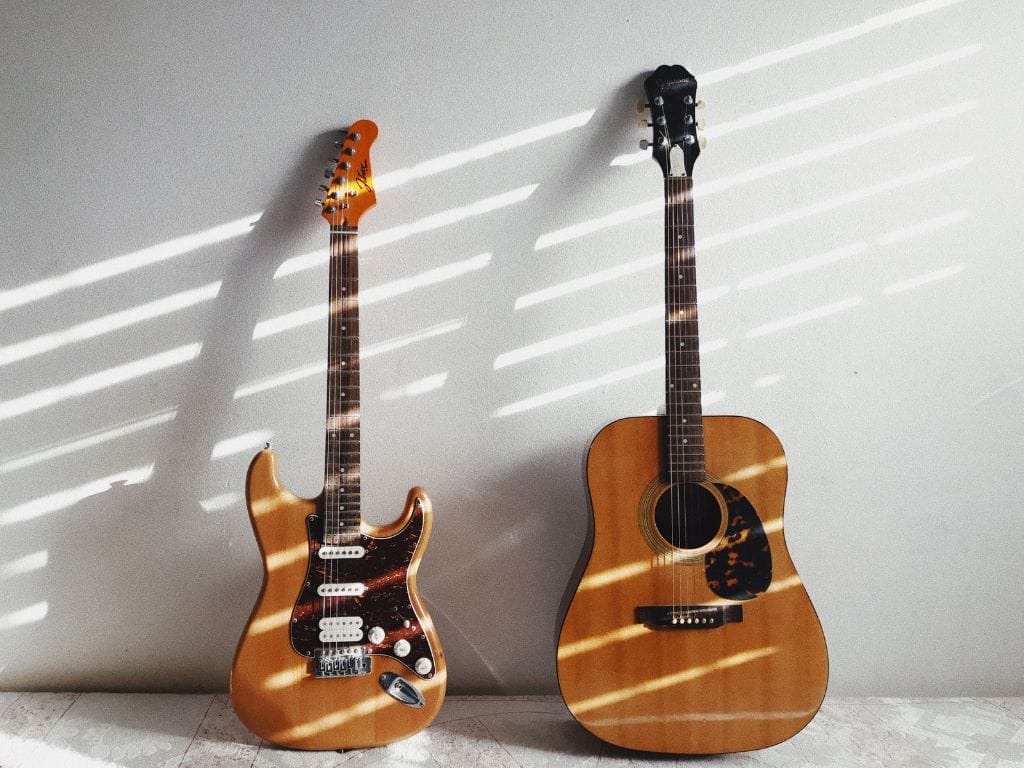Guitar Basics – Preparing for Your First Lesson
So. You’ve decided that you’d like to learn how to play the guitar, huh? Great decision! Guitar lessons take time and effort. It takes practice, time and patience to learn chords until you get them right. Then try to play songs by ear. When beginning to learn an instrument like guitar, one of the most important things beginners need to know is that they must be patient with themselves. It takes time for even the most talented musicians to develop their skills. You need to dedicate some time each week to practicing chords, scales, and technique for playing guitar. Even if it’s just a couple of minutes per day. Developing good habits is harder than breaking bad ones. Once you’re comfortable with music theory, you’ll be ready to pick up the guitar and start playing! In this article, we’ll cover the basic things you’ll need to get before you’re ready to start taking guitar lessons.

Table of contents
- No Time to Read? Here’s a Snappy Summary of This Article
- Guitar – First things first
- About acoustics guitars
- About classical guitars
- About electric guitars
- What else you will need to play a guitar
- Conclusion
- FAQ FOR GUITAR BASICS – PREPARING FOR YOUR FIRST LESSON
- Meanwhile, Check Out Tropika Club’s Ecosystem of Websites
No Time to Read? Here’s a Snappy Summary of This Article
- Musical Adventure Awaits: Embark on a thrilling journey into the world of guitar, unlocking melodies that resonate with your soul.
- Essential Gear Guide: Discover must-have tools, from choosing the right guitar to understanding accessories that elevate your playing experience.
- Fretboard Decoded: Unravel the mystery of the fretboard, turning frets into allies and unleashing your creativity with newfound fretboard mastery.
- Rhythm Revolution: Dive into the heart of music as you grasp the fundamentals of rhythm, transforming your playing into a rhythmic masterpiece.
- Chords Unveiled: Explore the magic of chords, unveiling the secrets behind harmonies that captivate listeners and define your signature sound.
- 6Practice with Purpose: Elevate your skills through strategic practice, blending discipline with passion, ensuring rapid progress on your musical voyage.
Guitar – First things first
First things first – understanding the instrument. Guitars come in various types, acoustic and electric being the main categories. Acoustic guitars, known for their natural sound, are great for beginners. They’re versatile, suitable for various genres, and don’t require additional equipment.
On the flip side, electric guitars offer a wide sonic range, often associated with rock and blues. They need an amplifier for proper sound projection. Consider your musical preferences and playing style when choosing between acoustic and electric.
Next, grasp the anatomy. From the headstock to the body, each part plays a role. The fretboard hosts frets where you press to create different notes and chords. The soundhole or pickups, depending on the type, capture the vibrations, translating them into sound.
Learning basic chords and strumming patterns lays a strong foundation. Mastering a few chords opens the door to countless songs. Invest time in finger strength and flexibility exercises – crucial for smooth chord transitions. Practice regularly to build muscle memory.
Tuning is paramount. Get a tuner or use online resources to ensure your guitar is in tune. Ears attuned to the right pitch enhance your playing experience. Lastly, explore resources like online tutorials, chord charts, and beginner-friendly songs. Stay patient and enjoy the journey – the first strum is just the beginning of a melodious adventure.

About acoustics guitars
Acoustic guitars, with their timeless resonance and simplicity, are cherished by musicians worldwide. Crafted from various tonewoods, these instruments produce warm, rich tones that captivate listeners. The hollow body design allows the guitar’s sound to resonate naturally, creating a full and well-balanced acoustic experience.
From the intimate strumming of folk tunes to the soulful melodies of blues and country, acoustic guitars lend themselves to a diverse range of musical genres. The portability of these instruments makes them ideal companions for songwriters, performers, and enthusiasts alike. Whether you’re gathered around a campfire or performing on stage, the acoustic guitar’s versatility shines through.
The choice of tonewood significantly influences the guitar’s sound. Spruce, cedar, mahogany, and rosewood are common tonewoods, each imparting distinct characteristics. Spruce, known for its clarity and brightness, is often chosen for the guitar’s top. Cedar, on the other hand, produces a warmer tone with a quicker response.
Mahogany, used for the guitar’s body and neck, contributes to a warm and balanced sound, while rosewood, often found in the back and sides, enhances the guitar’s depth and resonance. These tonewood combinations create a spectrum of sounds, allowing players to find the perfect match for their musical expression.
Beyond their sonic qualities, acoustic guitars come in various body shapes and sizes, such as dreadnought, concert, and parlor. Each shape influences the guitar’s projection, comfort, and tonal characteristics. Players can choose the body shape that best suits their playing style and preferences.
Acoustic guitars are also available in different string configurations, with steel-string and nylon-string being the most common. Steel-string guitars are popular in contemporary music, providing a bright and articulate sound, while nylon-string guitars offer a mellower tone suitable for classical and fingerstyle playing.
Read Also: Top 23 Best Singing Lesson Teachers and Schools in Singapore

About classical guitars
Classical guitars, revered for their timeless elegance and melodic richness, have graced the world of music for centuries. With a history deeply rooted in classical and flamenco traditions, these instruments are celebrated for their nylon strings, intricate craftsmanship, and resonant tonal qualities.
Crafted with meticulous attention to detail, classical guitars typically feature a body made from tonewoods like cedar or spruce for the top and mahogany or rosewood for the back and sides. This construction contributes to a warm and well-balanced sound, enhancing the nuances of fingerstyle and classical playing.
Nylon strings, a hallmark of classical guitars, provide a gentle touch under the fingers, making them ideal for intricate fingerpicking and expressive legato phrasing. The nylon strings produce a mellow and rounded tone, adding a distinct character to classical compositions, Spanish guitar pieces, and intimate acoustic performances.
The wider neck and flat fingerboard of classical guitars facilitate precise finger placement, allowing players to explore intricate chord voicings and execute complex classical techniques with ease. This makes classical guitars not only instruments of choice for classical musicians but also appealing to those exploring a wide range of genres, including folk, jazz, and world music.
The classical guitar’s versatility extends beyond its musical capabilities. Its timeless design, often characterized by a sleek, unadorned appearance, adds a touch of sophistication to any performance or collection. From the intricate rosette to the ornate headstock, classical guitars showcase the artistry and craftsmanship that goes into their creation.
Whether you’re a seasoned classical guitarist or a beginner captivated by the allure of classical music, these instruments offer a gateway to a world of expressive possibilities. With their rich heritage and enduring appeal, classical guitars continue to inspire musicians to explore the depths of musical expression, making them cherished companions on the journey of artistic discovery.
About electric guitars
Electric guitars, icons of sonic exploration, have revolutionized the music landscape. Their distinct sound, characterized by versatility and dynamics, makes them a staple in various genres, from rock and blues to jazz and beyond. Unlike acoustic guitars, electric guitars require an amplifier to amplify their sound.
Crafted for innovation, electric guitars boast sleek, contoured bodies and a range of pickup configurations. Single-coil pickups offer crisp, bright tones, while humbuckers deliver a fuller, warmer sound with reduced interference. This diversity allows players to sculpt their desired tone by selecting different pickup combinations.
The electric guitar’s neck design varies, influencing playability. Choose from a bolt-on neck for sharp attack or a set neck for smoother sustain. The fretboard material, often rosewood or maple, affects the guitar’s feel and resonance.
Dive into the world of effects pedals to shape your sound further. From distortion and delay to wah-wah and chorus, these pedals unleash endless sonic possibilities. Experimentation with effects enhances creativity and personal style.
String bending, vibrato, and tapping techniques characterize electric guitar playing. Develop a nuanced touch for expressive playing, creating emotive solos and captivating riffs. Understanding the whammy bar adds a dynamic element to your performance, allowing pitch manipulation.
When choosing an electric guitar, consider factors like body shape, tonewood, and pickup configuration. Brands like Fender and Gibson are renowned for their quality and innovation. Whether you’re a beginner or a seasoned player, the electric guitar invites you into a world of sonic exploration, where each note resonates with limitless possibilities.
What else you will need to play a guitar
To embark on your guitar journey, beyond the guitar itself, a few essentials enhance your playing experience. A tuner ensures your guitar is in tune, crucial for accurate sound. Invest in a comfortable strap for extended playing sessions, and a sturdy case or gig bag for protection and portability.
Quality picks come in various thicknesses, allowing you to explore different tones. An adjustable guitar stand keeps your instrument secure when not in use. Consider a capo for easy key changes and a slide for bluesy nuances.
A music stand or tablet holder aids reading sheet music or online tutorials. A metronome hones your sense of timing, vital for rhythmic precision. Invest time in finger exercises to build strength and dexterity, facilitating smooth chord transitions.
Learning resources, such as chord charts, online tutorials, and beginner-friendly songbooks, guide your practice. Don’t forget a comfortable chair for extended playing sessions. Finally, a positive mindset and patience are invaluable – enjoy the learning process and let your musical journey unfold organically.
Conclusion
Embark on a thrilling musical adventure into the world of guitar, unlocking melodies that resonate with your soul. Discover essential gear tips, from choosing the right guitar to understanding accessories that elevate your playing experience. Unravel the fretboard mystery, turning frets into allies and unleashing your creativity with newfound mastery.
Dive into the heart of music as you grasp the fundamentals of rhythm, transforming your playing into a rhythmic masterpiece. Explore the magic of chords, unveiling the secrets behind harmonies that captivate listeners and define your signature sound. Elevate your skills through strategic practice, blending discipline with passion for rapid progress on your musical voyage.

FAQ FOR GUITAR BASICS – PREPARING FOR YOUR FIRST LESSON
Q: Where can I find affordable and quality guitars in Singapore?
A: Explore popular music stores like Swee Lee and Davis Guitar for a wide range of affordable and quality guitars.
Q: Are there online platforms in Singapore for learning guitar basics?
A: Yes, platforms like Fretastic and Guitar Emerge offer online guitar lessons, catering to beginners in Singapore.
Q: What are some essential accessories I should consider for my first guitar lesson?
A: Invest in accessories like a sturdy guitar bag, a tuner, and a comfortable guitar strap for a smooth and enjoyable learning experience.
Q: Can you recommend any local music schools in Singapore for beginners?
A: Check out Yamaha Music School and Believer Music for reputable music schools in Singapore offering beginner-friendly guitar lessons.
Q: Are there any local communities or meetups for beginner guitarists in Singapore?
A: Join Singapore Music Lovers on Meetup or Guitar Singapore on Facebook to connect with fellow beginners and experienced guitarists.
Q: How can I balance practice with a busy schedule?
A: Incorporate short, focused practice sessions into your daily routine and consider online resources for flexible learning to suit your schedule.

Have an Article to Suggest?
Tropika Club is always looking for new and exciting content to feature in their magazine and they value the input of our readers. If you have any noteworthy content or articles that you believe would be a great addition to Tropika Club’s magazine, we are open to suggestions and encourage you to reach out to us via email at [email protected]. By doing so, Tropika Club values your expertise and knowledge in the matter and appreciates your willingness to help. We will review your recommendations and update our list accordingly
Meanwhile, Check Out Tropika Club’s Ecosystem of Websites
Tropika Club Magazine – Tropika Club Magazine is a Singapore-based publication that features articles on a wide range of topics with a focus on local businesses and content for the region. The magazine emphasizes supporting local businesses through its #SupportLocal initiative, which includes coverage of everything from neighborhood hawker stalls to aesthetic clinics in town. In addition to highlighting local businesses, Tropika Club Magazine also covers a variety of local content, including beauty, lifestyle, places, eats, and what’s on in Singapore and the Asia Pacific region.




